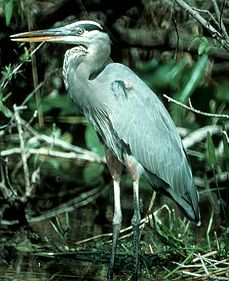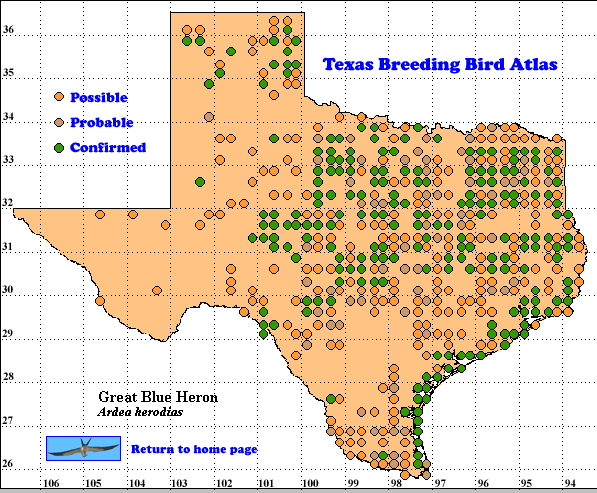The Great Blue Heron is abundant, widespread, and well-known throughout its range in Texas. It is highly adaptable, both in habitat requirements and diet. From about 1860 until 1907, its breeding plumes as well as those of Snowy Egrets (Egretta thula) and Great Egrets (E. alba) were in demand in the millinery trade where they were used to adorn women’s hats. There are reports of Great Blue Heron plume collecting on the Texas coast in Flour Bluff (Nueces County) and Refugio County (Casto 1983). However, their populations were not decimated as were those of the egrets.
In Texas, an important influence on waterbird populations is the 20-25 year precipitation cycle (Telfair 2002). Between the early 1960s and late 1980s, there was a significant upward trend in the cycle; since then, the trend has begun to decrease (Tom Spencer, Texas Forest Service, pers. comm.). The trend varies regionally and there are intermittent drought years and irregular intervals with pronounced wet/dry springs-summers such as those associated with El Niño/La Niña years and massive slow-moving atmospheric disturbances (Dr. Robert K. Peters, NWS Observer for Tyler, Texas, pers. comm.). Inland wetland habitats are particularly subject to the effects of these trends. Unfortunately, there is a lack of data about the status of the Great Blue Heron in Texas before the 1970s; so, the possible relationship between its breeding populations and the precipitation cycle are unknown for earlier years. However, this species is highly adaptive and often feeds away from water; so, it may not be as susceptible to wet/dry precipitation cycles as are other heron and egret species.
The large size and relatively small number of Great Blue Herons per colony probably insure that census data are fairly accurate compared to the smaller yet much more numerous species with which they nest.
DISTRIBUTION: Great Blue Herons are associated with water; however, they inhabit a vast array of habitats, and often feed in dry areas. Examples of habitats include: fresh and salt marshes, swamps, estuaries, seashores, tidal flats, meadows, island shores, river and creek banks, oxbow lakes, and human-made habitats, e.g., flooded agricultural fields and pastures, ditches, canals, agricultural and aquaculture ponds, and reservoirs (Kushlan and Hancock 2005).
Great Blue Herons nest singularly or insingle species or multi-speciescolonies throughout most of Texas. The largest colonies are in the forested east inland region and on coastal islands where they nest with other species of colonial waterbirds. Breeding has been recorded in all regions of Texas; but, until 1998, there was only one record from the Trans-Pecos region — at El Paso in El Paso County (Oberholser 1974). In 1998, a pair nested at McNary Reservoir in Hudspeth County (Lasley et al. 1998). Based upon Texas colonial waterbird censuses (1973-1990), most of the breeding population is coastal (49-91%).
SEASONAL OCCURRENCE: Breeding occurs from late January to late-August, with eggs found from February 20-June 17 and nestlings present from March 23-July 21 (Oberholser 1974). Great Blue Herons are uncommon to common summer residents throughout eastern Texas, especially along the Coastal Prairies region and immediate coast; locally common to scarce and irregular in the western half of Texas. In winter, northern birds move south into coastal areas (Oberholser 1974, Lockwood and Freeman 2004).
BREEDING HABITAT: Great Blue Herons nest in single pairs or in single-species or multi-species colonies. They tend to nest in relatively undisturbed sites where they are buffered from disturbance, e.g., in areas of low road density and where they are surrounded by large areas of forest (Gibbs and Kinkel 1997) as well as isolated islands. Typical nesting habitats include lowland swamps, upland hardwood forests, islands, forest-bordered oxbows, ponds, reservoirs, and riparian woodlands, including conifers (Butler 1992). However, nest sites are highly variable: trees, shrubs, duck blinds, channel markers, artificial nest platforms, on the ground on coastal islands; and, in west Texas, dead trees in cattle ponds and on cliff sites. Nests are usually in trees up to 30 m (100 ft) or higher above ground. Where trees are not available, they will nest on the ground, usually on predator-free islands (Butler 1992).
STATUS: According to Texas colonial waterbird censuses from 1973-1990, the breeding population of the Great Blue Heron fluctuated between 1,414 and 3,785 pairs. Data from these censuses for Great Blue Herons reveal an annual decreasing trend of -1.7%. Unfortunately, comprehensive inland annual breeding censuses have not been conducted since 1990. However, coastal data between 1973-2000 were analyzed by McFarlane (2002). He found a highly significant annual decreasing trend of -3.7%. Nevertheless, within these time spans, there were years with high census numbers; so, the decline may be related to regional responses to the precipitation cycle (see Introduction and Distribution discussions above). North American Breeding Bird Survey (BBS) data for Texas (Sauer et al. 2005) give annual trends of 9.9% (1966-1979), 1.7% (1980-2005), and 2.1% (1966-2005); thus, indicating an overall upward trend statewide in contrast to the decreasing trend shown by colonial waterbird census data. However, the BBS data for the Coastal Prairies (in agreement with the analysis of MacFarlane [2002]) indicate a decreasing trend: +3.49% (1966-1979), -2.97% (1980-2005), and -0.04% (1966-2005) as reported by Sauer et al. (2005).
Text by Raymond C. Telfair II (2007)
Literature cited.
Butler, R. W. 1992. Great Blue Heron (Ardea herodias) InThe Birds of North America, No. 25 (A. Poole, P. Stettenheim, and F. Gill, eds.). The Birds of North America, Inc., Philadelphia, PA.
Casto, S. D. 1983. The market hunting of Texas birds. Bull. Texas Ornithol. Soc. 16: 2-15.
Gibbs, J. P. and L. K. Kinkel. 1997. Determinants of the size and location of Great Blue Heron colonies. Colonial Waterbirds 20: 1-7.
Kushlan, J. A. and J. A. Hancock. 2005. The herons. Oxford University Pres, New York.
Lasley, G. W., C. Sexton, M. Lockwood, and C. Shackelford. 1998. Texas region (nesting season). Field Notes 52: 475-479.
Lockwood, M. W. and B. Freeman. 2004. The TOS handbook of Texas birds. Texas A&M. University Press, College Station.
McFarlane, R. W. 2002. Texas colonial waterbird trends (Powerpoint presentation). http://www.fws.gov/texascoastalprogram/TCWC.htm.
Oberholser, H. C. 1974. The bird life of Texas. University of Texas Press, Austin.
Sauer, J. R., J. E. Hines, and J. Fallon. 2005. The North American Breeding Bird Survey, results/analysis 1966-2005. Version 6.2.2006. USGS Patuxent Wildl. Res. Cnt., Laurel, Maryland. http://www.mbr-pwr.usgs.gov/bbs/bbs.html.
Telfair, R. C. II. 2002. Inland heronries in Texas. Texas Partners in Flight Newsletter, Texas Parks and Wildl. Dept. 9: 20.

